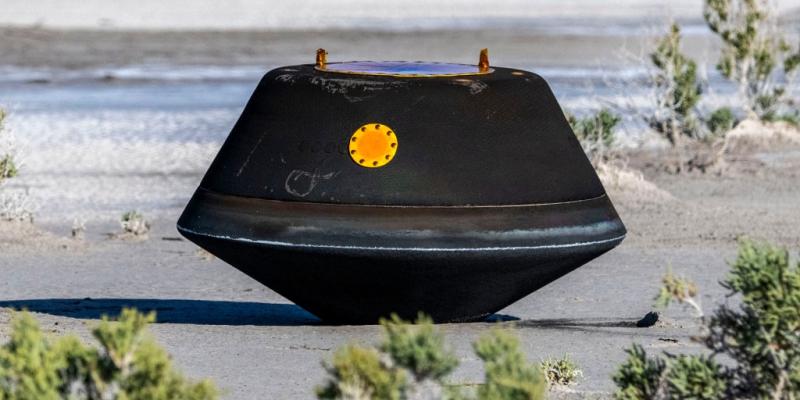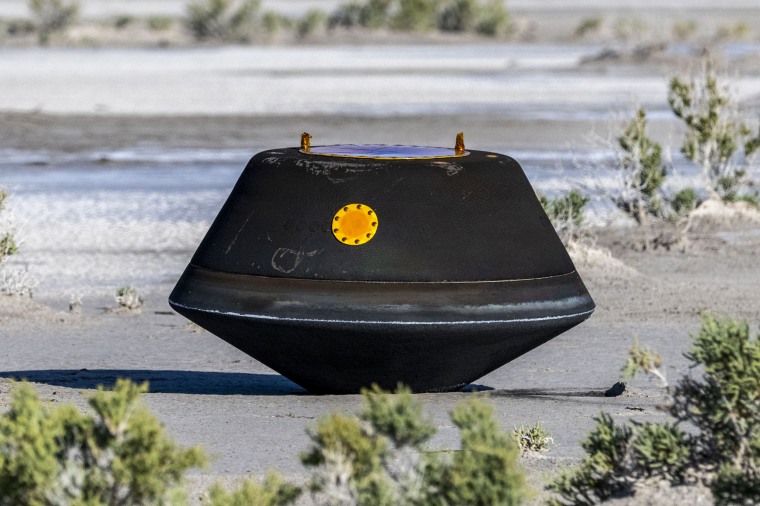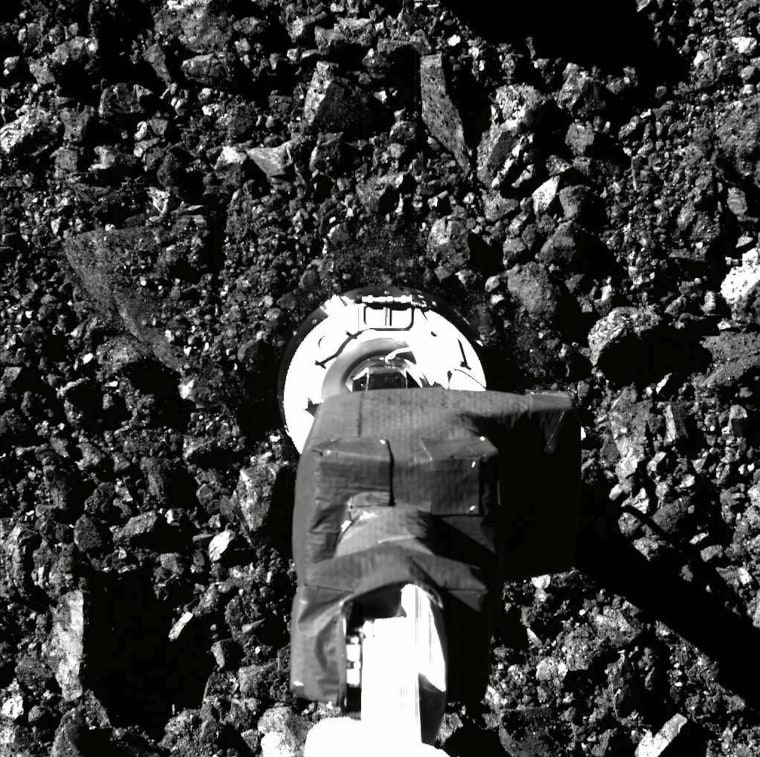In a first, NASA returns asteroid samples to Earth



A capsule containing precious samples from an asteroid landed safely on Earth on Sunday, the culmination of a roughly 4-billion-mile journey over the past seven years.
The asteroid samples were collected by NASA's OSIRIS-REx spacecraft, which flew by Earth early Sunday morning and jettisoned the capsule over a designated landing zone in the Utah desert. The unofficial touchdown time was 8:52 a.m. MT, 3 minutes ahead of the predicted landing time.
The dramatic event — which the NASA livestream narrator described as "opening a time capsule to our ancient solar system" — marked a major milestone for the United States: The collected rocks and soil were NASA's first samples brought back to Earth from an asteroid. Experts have said the bounty could help scientists unlock secrets about the solar system and how it came to be, including how life emerged on this planet.

Bruce Betts, chief scientist at The Planetary Society, a nonprofit organization that conducts research, advocacy and outreach to promote space exploration, congratulated the NASA team on what he called an "impressive and very complicated mission," adding that the asteroid samples are the start of a thrilling new chapter in space history.
"It's exciting because this mission launched in 2016 and so there's a feeling of, 'Wow, this day has finally come,'" he said. "But scientifically, it's exciting because this is an amazing opportunity to study a very complex story that goes way back to the dawn of the solar system."
 The sample return capsule from NASA's Osiris-Rex mission in Utah on Sunday.Keegan Barber / NASA via AP
The sample return capsule from NASA's Osiris-Rex mission in Utah on Sunday.Keegan Barber / NASA via AP
The samples were gathered from the surface of a near-Earth asteroid known as Bennu. The space rock, which is roughly as tall as the Empire State Building, is located more than 200 million miles away from Earth but orbits in such a way that it occasionally swings within 4.6 million miles of the planet.
Bennu's main draw owes to its age. The asteroid is estimated to have formed in the first 10 million years of the solar system's existence, making it a pristine remnant from a chaotic time more than 4.5 billion years ago. As such, studying an asteroid's chemical and physical properties is thought to be one of the best ways to understand the earliest days of the solar system.
"They're pretty well untouched from right around 4.5 billion years ago," Betts said. "To get insights into these rocks gives real power to not just the science of asteroids but to everything in our solar system."
Researchers are keen to understand what role — if any — asteroids played in the emergence of life on Earth. There are theories, for instance, that asteroids and comets may have delivered water and other building blocks of life to the planet.
Bennu has also been of interest to scientists because, like other near-Earth asteroids, it is classified as a potentially hazardous object. NASA's Planetary Defense Coordination Office previously estimated that there is a 1 in 2,700 chance of Bennu slamming into Earth sometime between the years 2175 and 2199.
It's estimated that the sample return capsule contains around 8.8 ounces of rocky material from Bennu. After it is recovered, the capsule will be transported to a temporary clean room on the military range before being flown to NASA's Johnson Space Center in Houston.
Agency officials said they hope to open the capsule on Monday or Tuesday, though it may take around a week before scientists can accurately weigh how much rocky material is inside.
 The Origins, Spectral Interpretation, Resource Identification, Security, Regolith Explorer (OSIRIS-REx) spacecraft unfurled its robotic arm on Oct. 20, and in a first for the agency, it briefly touched a well-preserved, ancient asteroid, known as Bennu, to collect dust and pebbles from the surface for delivery to Earth in 2023.NASA/Goddard/University of Arizona
The Origins, Spectral Interpretation, Resource Identification, Security, Regolith Explorer (OSIRIS-REx) spacecraft unfurled its robotic arm on Oct. 20, and in a first for the agency, it briefly touched a well-preserved, ancient asteroid, known as Bennu, to collect dust and pebbles from the surface for delivery to Earth in 2023.NASA/Goddard/University of Arizona
The OSIRIS-REx spacecraft (short for Origins, Spectral Interpretation, Resource Identification, Security-Regolith Explorer) spent nearly two years circling Bennu before using its robotic arm in what was described as a "high five" maneuver to scoop up pieces of the space rock.
Early Sunday, the spacecraft jettisoned the samples as it skirted 63,000 miles above Earth's surface, sending the capsule screaming through the atmosphere at around 27,650 mph. A series of parachutes helped slow the capsule before it touched down in Utah's western desert.
While these are NASA's first samples collected and brought back from an asteroid, they are not the first in history. Japan's Hayabusa mission in 2010 delivered to Earth a few micrograms of material from an asteroid called Itokawa. A second mission, dubbed Hayabusa2, delivered to Earth a small sample from an asteroid known as Ryugu in December 2020.
The $1 billion OSIRIS-REx spacecraft may have completed its high-profile delivery, but the probe is not yet finished with its journey. After releasing the sample capsule, the spacecraft fired its thrusters to take it beyond Earth and on a course to investigate another asteroid known as Apophis. This space rock, which measures about 1,200 feet across, is projected to come within 20,000 miles of Earth in 2029.
As part of its extended mission, the OSIRIS-REx spacecraft will take careful measurements of the space rock's orbit. NASA also intends to approach Apophis and use the spacecraft's gas thrusters to dislodge and study rocky material from the asteroid.



Hopefully it did not carry a virus, as in the movie "The Andromeda Strain".
Just last night we watched the 1980's remake of "The Blob" which the plot line was that we sent up a capsule with germs aboard that mutated in space as a way to produce a bioweapon. The capsules in the movie and this one are very similar.
Own a meteorite I found in the 'back 40' a few years back.
It was a recent strike as the pit was still there.
The size of my fist and I took pictures for proof.
Don't need the money so I'm keeping it.
Humans have a hard time grasping large numbers like this, so to put it into perspective...
1 billion seconds is roughly 31.5 years.
Huh?
It was an important scientific event.
I wonder how many people even know about it?
According to this, at least six.
You can find good things on NT
What I found really amazing was when the craft touched down on the asteroid and how the low impact disturbed the surface not just how low the gravity was but also how loosely put together the asteroid is.
Another thing that wouldn't surprise me, we have been hit by meteors that were the remnants of a Mars asteroid collision and the samples we get from this expedition may only yield more Mars debris that this asteroid has been vacuuming up not the 4.5 billion year old samples their looking for. This asteroid has been moving through the same stuff we've been.
There are a lot of things that may come from this. They are also trying to find out if water is present on these asteroids.
Unless this asteroid is tidal locked with the sun, there may be water on the backside but with any heat at all water will just vaporize into the vacuum of space. That's why the only water on the moon, unless its buried deep, is in craters at the poles where the sun's energy never reaches it and it is in the form of ice. The debris on the surface of this asteroid has all had its day in the sun.
Now with the vote up's, ten.
Eleven.